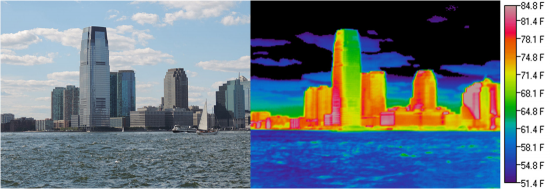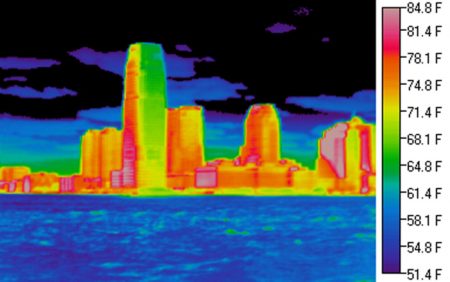June 19, 2017 – In the May 29th edition of Nature Climate Change, a study authored by researchers from Sussex University, Mexico, and The Netherlands, concludes that climate change will intensify the urban heat island (UHI) effect in coming decades and by the end of the century cities will be 25% hotter than today. Their study of 1,692 cities around the globe suggests a mean average increase of 7 Celsius (over 11 Fahrenheit) degrees.
What is the urban heat-island effect?
Ever visited Washington, DC, in the summer? My wife and I remember a July trip a number of years ago where we found ourselves near the Washington Mall in the middle of what felt like a furnace. If we had dropped an egg on the sidewalk I believe it would have fried. What causes cities to get so hot in summer months? In a posting written back in April of 2012, I talked about how a little bit of white paint could change the heat cities experience in the summer months, that the phenomenon that makes a city warmer than its surroundings was a human construct: dark pavement, lack of trees and parkland, dark roofs, and burning fossil fuels for heating, cooling, industry, and urban transit, all contributed to a rise in air temperatures. The idea that making pavement and roofs more heat reflective by painting them white could make a city a little cooler.
The researchers looked at historic temperature data from cities dating from 1950 to 2015 and discovered that 65% of urban populations experienced warming above the world mean average amounting to an increase of 0.6 Celsius (1.08 Fahrenheit) degrees. That is a warming pace twice the mean global temperature increase over the same period of time. They then projected based on current trends just how much warmer cities will be by 2050 and calculated a heat-island effect of 2 Celsius (3.6 Fahrenheit) over the global mean average increase in temperature which presently appears to be heading to at least 2 Celsius. So that means cities by 2050 will be 4 Celsius (7.2 Fahrenheit) degrees warmer on summer days that their surroundings. And looking at trends to 2100 based on worst case scenarios where climate change mitigation and adaptation policies prove too weak to reduce carbon emissions, the researchers projected increases in the UHI effect of 7 Celsius (11 Fahrenheit) over and above the mean global average increase in temperatures.
The researchers were interested in translating a growing UHI effect into economic terms. Since 80% of gross domestic product today comes from cities, would temperature increases have a negative impact on economic growth? Their conclusions, that as global warming intensifies the impact on cities will cause an 11% drop in economic output.
Urban climate policy initiatives can significantly mitigate UHI impacts. Cities occupy only about 1% of the Earth’s land mass although 54% of us live in them today and two-thirds of us by 2050 based on current trends. So climate change policy focused on cities could have the greatest impact on humanity in the short term.
What type of policies can cities implement to mitigate the UHI effect?
- Provide urban dwellers with a lot of white paint. Painting roofs and paved open spaces white have the same impact as white snow has in winter months. All reflect solar radiation back to space rather than allow it to heat up the ground and transfer the warmth to the air directly above.
- Create an urban green roof policy with incentives for buildings to convert existing roof systems.
- Create renewable energy incentives for homeowners and buildings (residential and commercial) with the installation of solar and storage microgrid systems.
- Expand mass urban transit infrastructure including the electrification of light-rail and subways to reduce emissions within city boundaries.
- Build out a recharging infrastructure for electric vehicles (EVs) and a hydrogen refueling infrastructure for fuel-cell powered vehicles.
- Create odd and even license plate days to reduce the number of cars on city streets.
- Increase forests and parkland within urban centers and provide tree planting initiatives to encourage homeowners to add trees to their gardens.
But cities alone cannot solve global warming’s total impact on the planet. The authors of the study on the UHI effect state in their conclusions that the largest benefits to reduce climate change impacts will only come, however, with a combination of global and urban policy implementation. Cities going it alone cannot stop the mean average warming of the planet.
And as a countermeasure to the negative economic impact, the study states, “the implementation of international actions to stabilize the atmospheric concentrations of greenhouse gases would make investing in local measures to control the UHI effect more attractive as it would have a higher return on investment.”










